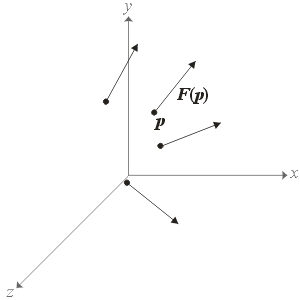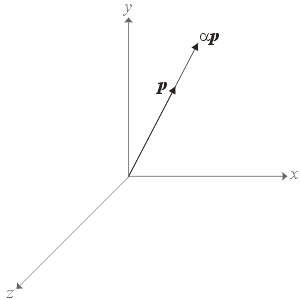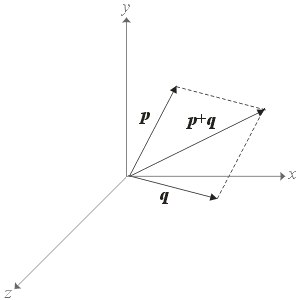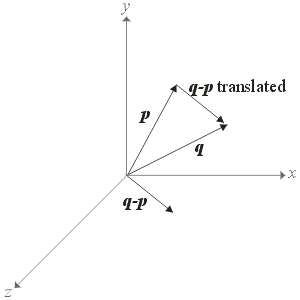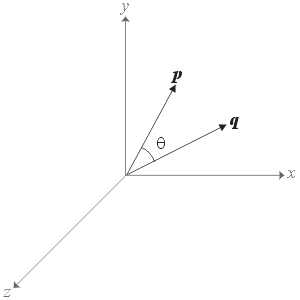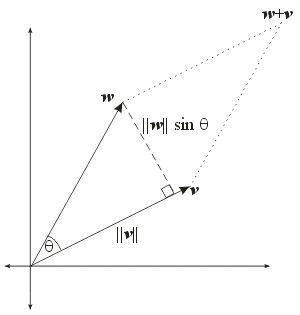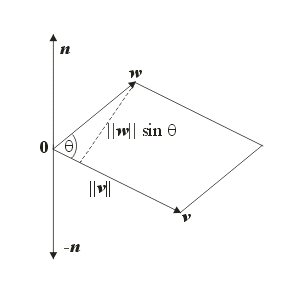Vector Mathematics in 3D
An Introduction to 3D Vectors
|
|
Prof. David Bernstein
James Madison University
|
|
| Computer Science Department |
| bernstdh@jmu.edu |

|
Some Notation
- The Set of Real Numbers:
- \(\mathbb{R}^{1} \doteq \mathbb{R}\)
- The Set of Ordered Triples of Real Numbers:
- \(\mathbb{R}^{3} \doteq \mathbb{R} \times \mathbb{R} \times \mathbb{R}\)
Members of \(\mathbb{R}^{3}\)
- The Notation You Are Most Familiar With:
- A More Convenient Notation:
- \(\bs{p} = (p_{x}, p_{y}, p_{z})\)
- A Still More Convenient Notation:
- \(\bs{p} = (p_{1}, p_{2}, p_{3})\)
Two Things to be Aware Of
- Orientation:
- It sometimes matters whether we think of the ordered pair as
a "row" or a "column", though we won't distinguish for now
- An example of a "row": \(\bs{p} = [p_1 \quad p_2 \quad p_3]\)
- An example of a "column": \(\bs{p} = \left[ \begin{array}{c}p_1 \\ p_2 \\ p_3 \end{array} \right]\)
- Points and Directions:
- In is sometimes important to distinguish between
different kinds of ordered pairs (e.g., points and directions)
- We won't distinguish for now except in visualizations
Visualization
Points
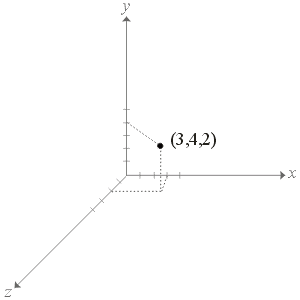
Visualization (cont.)
Directions
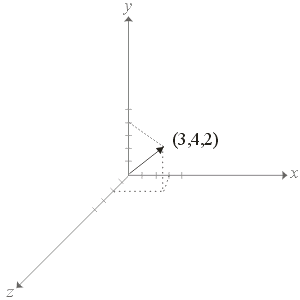
Vector Fields
- Definition:
- A vector field is a map
\(F: A \subset \mathbb{R}^{3} \rightarrow \mathbb{R}^{3}\)
that assigns to each point \(\bs{p} \in A\)
a vector \(F(\bs{p})\)
- Visualization:
Multiplication by a Scalar
- Definition:
- Given \(\alpha \in \mathbb{R}\) and
\(\bs{p} \in \mathbb{R}^{3}\)
- \(\alpha \bs{p} = (\alpha p_{1}, \alpha p_{2}, \alpha p_{3})\)
- Visualization:
Addition
- Definition:
- Given \(\bs{q} \in \mathbb{R}^{3}\) and \(\bs{r} \in \mathbb{R}^{3}\)
- \(\bs{q} + \bs{r} = (q_{1}+r_{1}, q_{2}+r_{2}, q_{3}+r_{3})\)
- Visualization:
Subtraction
- Definition:
- Given \(\bs{q} \in \mathbb{R}^{3}\) and \(\bs{r} \in \mathbb{R}^{3}\)
- \(\bs{q} - \bs{r} = (q_{1}-r_{1}, q_{2}-r_{2}, q_{3}-r_{3})\)
- Visualization:
The Standard Basis
- Three Important Vectors:
- \(\bs{i} = (1, 0, 0)\)
- \(\bs{j} = (0, 1, 0)\)
- \(\bs{k} = (0, 0, 1)\)
- A General Representation of Vectors in \(\mathbb{R}^3\):
- Suppose \(\bs{q} = (q_{1}, q_{2}, q_{3})\), then
- \(\bs{q} = q_{1} \bs{i} + q_{2} \bs{j} + q_{3} \bs{k}\)
The Standard Basis (cont.)
Visualization
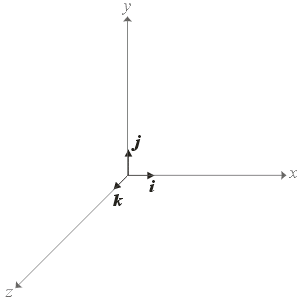
The Standard Basis (cont.)
- An Important Observation:
- Every vector \(\bs{p}\) can be written as
\(\bs{p} = \alpha \bs{i} + \beta \bs{j} + \gamma \bs{k}\)
when \(\alpha\), \(\beta\)
and \(\gamma\) are chosen appropriately
- As in Two Dimensions:
- \(\bs{p}\) is then said to be a
linear combination
of \(\bs{i}\), \(\bs{j}\), and \(\bs{k}\)
- \(\bs{i}\), \(\bs{j}\), and \(\bs{k}\)
are said to be
linearly independent
The Inner (Dot) Product
- Two Notations:
- \(\bs{p} \cdot \bs{q}\)
- \(\lt \bs{p}, \bs{q} \gt\)
- Definition:
- Given \(\bs{p} \in \mathbb{R}^{3}\) and \(\bs{q} \in \mathbb{R}^{3}\)
- \(\bs{p} \cdot \bs{q} = \sum_{i=1}^{3} p_{i} q_{i}
= p_{1} q_{1} + p_{2} q_{2} + p_{3} q_{3}
\)
The Euclidean Norm (Length) of a Vector
- The (Euclidean) Length of a Vector:
- \(||\bs{p}|| = \sqrt{\sum_{i=1}^{3} p_{i}^{2}} =
\sqrt{p_{1}^{2} + p_{2}^2 + p_{2}^2}\)
- An Observation:
- \(\bs{p} \cdot \bs{p} = p_{1}^{2} + p_{2}^2 + p_{3}^2\)
- Substituting:
- \(||\bs{p}|| = (\bs{p} \cdot \bs{p})^{\frac{1}{2}}\)
Unit Vector
- Definition:
- A vector with a norm (i.e., length) of 1
- Three Examples Revisited:
- \(\bs{i} = (1, 0, 0)\)
- \(\bs{j} = (0, 1, 0)\)
- \(\bs{k} = (0, 0, 1)\)
Normalization
- Definition:
- The normalization of a vector \(\bs{p}\)
is \(\frac{\bs{p}}{||\bs{p}||}\)
(i.e., the vector divided by its norm)
- An Observation:
- \(||\bs{p}||\) is a scalar so normalization involves
multiplication by a scalar
- Relationship to Unit Vectors:
-
\(
\left\| \frac{\bs{p}}{||\bs{p}||} \right\| = 1
\)
The Angle Formed by Vectors
- Getting Started:
- The Plane Formed by the Vectors:
- \(\bs{p}\) and \(\bs{q}\) define a plane
- So, what we learned about 2D vectors applies here
- From the Law of Cosines:
- \(\theta = \cos^{-1} \frac{\bs{p} \cdot \bs{q}}{||\bs{p}|| \enspace||\bs{q}||}\)
Cross Product
- Definition:
- Given two vectors \(\bs{v}, \bs{w} \in \mathbb{R}^{3}\),
the vector
\(\bs{u} \in \mathbb{R}^{3}\) defined as:
- \(\bs{u} = (v_{2}w_{3} - w_{2}v_{3},
v_{3}w_{1} - w_{3}v_{1},
v_{1}w_{2} - w_{1}v_{2})\)
- is called the cross product of
\(\bs{v}\) and \(\bs{w}\)
- An Example:
- Let \(\bs{v} = \left[ \begin{array}{c}1 \\ 0 \\ 2\end{array}\right]\)
and \(\bs{w} = \left[ \begin{array}{c}5 \\ 3 \\ 4\end{array}\right]\). Then:
- \(\bs{u} = \bs{v} \times \bs{w} = \left[ \begin{array}{c}0 \cdot 4 - 3 \cdot 2 \\
2 \cdot 5 - 4 \cdot 1 \\
1 \cdot 3 - 5 \cdot 0\end{array}\right]
= \left[ \begin{array}{c}-6 \\ 6 \\ 3\end{array}\right]\)
- Be Careful:
- Unlike the inner (or dot) product, the cross product
is a vector
- Don't confuse this with the cross product of two sets
- Don't confuse the different uses of the
symbol \(\times\)
Cross Product (cont.)
- A Simple Case:
- Suppose both vectors are in the \(xy\)-plane
so that:
- \(\bs{v} = a \bs{i} + b \bs{j} = \left[ \begin{array}{c}a \\ b \\ 0\end{array}\right]\) and
\(\bs{w} = d \bs{i} + e \bs{j} = \left[ \begin{array}{c}d \\ e \\ 0\end{array}\right]\)
- Hence:
- \(u = \bs{v} \times \bs{w} =
\left[ \begin{array}{c}0 \\ 0 \\ ae - bd\end{array}\right]\)
- Visualization:
-
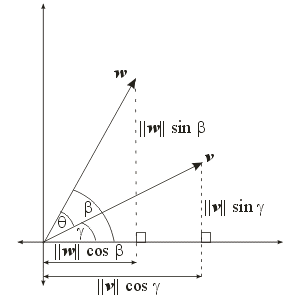
- \(a = ||\bs{v}|| \cos \gamma\)
- \(b = ||\bs{v}|| \sin \gamma\)
- \(d = ||\bs{w}|| \cos \beta\)
- \(e = ||\bs{w}|| \sin \beta\)
- A Simple Derivation:
- (1) \(|| \bs{v} \times \bs{w} || = | ae - bd |\)
- (2) \(|| \bs{v} \times \bs{w} || =
| \enspace
||\bs{v}|| \cos \gamma \cdot ||\bs{w}|| \sin \beta -
||\bs{v}|| \sin \gamma \cdot ||\bs{w}|| \cos \beta
\enspace |
\)
- Since \(\sin (\beta - \gamma) = (\sin \beta \cos \gamma -
\cos \beta \sin \gamma)\) it follows that:
- (3) \(|| \bs{v} \times \bs{w} || = ||\bs{v}|| \enspace ||\bs{w}|| \sin(\beta - \gamma) =
||\bs{v}|| \enspace ||\bs{w}|| \sin \theta\)
Cross Product (cont.)
- The Visualization Revisited:
- An Interpretation:
- \(|| \bs{v} \times \bs{w} || = ||\bs{v}|| \enspace ||\bs{w}|| \sin \theta\)
which is the (unsigned) area of the parallelogram formed
by \(\bs{v}\), \(\bs{w}\), and \((\bs{v}+\bs{w})\)
Cross Products (cont.)
- An Important Property:
- \(\bs{v} \times \bs{w}\) is orthogonal to both
\(\bs{v}\) and \(\bs{w}\) (and, hence, all vectors in
the plane they form)
- Proof:
- \((\bs{v} \times \bs{w}) \cdot \bs{v} =
(v_1 v_2 w_3 - v_1 w_2 v_3) + (w_1 v_2 v_3 - v_1 v_2 w_3) +
(v_1 w_2 v_3 - w_1 v_2 v_3) = 0\)
- \((\bs{v} \times \bs{w}) \cdot \bs{w} =
(w_1 v_2 w_3 - w_1 w_2 v_3) + (w_1 w_2 v_3 - v_1 w_2 w_3) +
(v_1 w_2 w_3 - w_1 v_2 w_3) = 0\)
- An Observation:
- This property is sometimes used as the defition of the cross
product
Normal Vectors
- Definition:
- A vector that is perpendicular to a surface
- An Observation:
- In three dimensions a normal can point either "inward"
or "outward"
- The Right Hand Rule for Cross Products:
- Point the fingers of your right hand in the direction of
the first vector and curl them around to the second vector. Your
thumb will point in the positive direction.
-
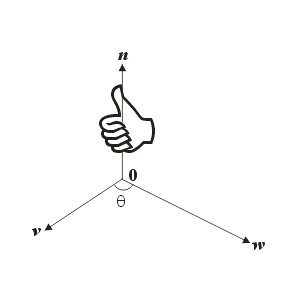
- An Alternative Definition of the Cross Product:
- \(\bs{v} \times \bs{w} = ||\bs{v}|| \cdot ||\bs{w}||
\cdot \sin(\theta) \cdot \bs{n}\) where \(\bs{n}\) is the
unit normal to the plane
Scalar Triple Product
- Definition:
- Given \(\bs{v}, \bs{w}, \bs{u} \in \mathbb{R}^{3}\), the
scalar triple product is defined as:
- \(\bs{u} \cdot (\bs{v} \times \bs{w})\)
- Visualization:
-
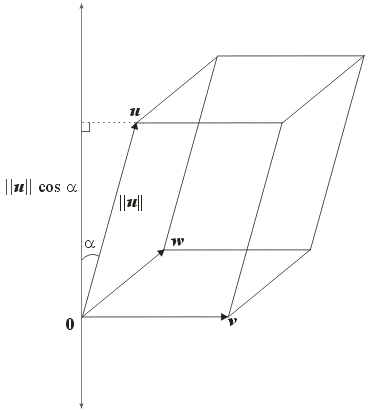
- The area of the parallelogram formed by \(v\)
and \(\bs{w}\) is \(||\bs{v} \times \bs{w}||\)
- The volume of the parallelepiped is
\(||\bs{u}|| \cos \alpha ||\bs{v} \times \bs{w}||\)
- From the Law of Cosines: \(||\bs{a}|| \cos \alpha ||\bs{b}||
= \bs{a} \cdot \bs{b}\)
- So, the volume of the parallelepiped is
\(\bs{u} \cdot (\bs{v} \times \bs{w})\)
The Cross Product Revisited
- A Special Case:
- Replace \(\bs{u}\) with the unit normal \(n\)
- Visualization:
- Interpretation:
- Given the definition of \(\bs{n}\) we know that
\(||\bs{n}|| = 1\)
- So, ignoring units, the volume of this parallelepiped
is the same as the area of the parallelogram
- We can use \(||\bs{n}|| \cos \alpha ||\bs{v} \times \bs{w}|| =
\bs{n} \cdot (\bs{v} \times \bs{w})\)
as the signed area of the
parallelogram


